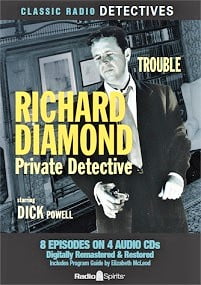
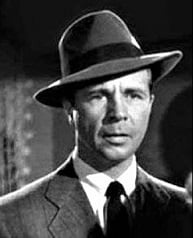 Richard Diamond, Private Detective (1949-52) aired “The Betty Moran Case” (aka “Double Murder”) on May 29, 1949 as its 6th episode of some 141. This is only the third Richard Diamond episode we’ve presented, the first being from early November of 2019 and the second and most recent from June of this year. Due to the popularity of the two earlier shows I thought it might be a good idea to treat Diamond fans with another in relatively quick succession. Therefore–for newcomers to the show and others wishing to refresh their memories–I reprise in abbreviated form our earlier historical sketch of the program and its recurring characters.
Richard Diamond, Private Detective (1949-52) aired “The Betty Moran Case” (aka “Double Murder”) on May 29, 1949 as its 6th episode of some 141. This is only the third Richard Diamond episode we’ve presented, the first being from early November of 2019 and the second and most recent from June of this year. Due to the popularity of the two earlier shows I thought it might be a good idea to treat Diamond fans with another in relatively quick succession. Therefore–for newcomers to the show and others wishing to refresh their memories–I reprise in abbreviated form our earlier historical sketch of the program and its recurring characters.
The show originally aired over NBC stations, then ABC, and then finally in 1953 by CBS, but all of the CBS shows were repeats from the 1950-51 season, thus some old time radio sites list the show’s run as going into 1953. Richard Diamond (starring film icon Dick Powell, 1904-1963, photo at right) was an ex-cop turned private detective who maintained good relations with his ex-boss and police lieutenant Walter Levinson (played by Ed Begley [1901-1970], probably most recognizable as juror #10 in the classic 1957 film Twelve Angry Men, and father to actor Ed Begley, Jr.). Diamond’s girlfriend, Helen Asher, was played by Virginia Gregg (1916-1986), who went on to have many film and television roles (including the Twilight Zone episode “The Masks” which aired March 20, 1964). The character of Richard Diamond–and the radio program itself–was the brainchild of Blake Edwards (1922-2010), perhaps best known for writing and directing the Pink Panther movies, as well as directing other fine films such as Operation Petticoat (1959), Breakfast at Tiffany’s (1961), and Days of Wine and Roses (1962). Blake’s private detective Richard Diamond didn’t exactly fit the standard mold people were used to, as typified in the novels of Dashiell Hammett and Raymond Chandler. While he could wisecrack with the best of them, he was also suave and sophisticated and tough as nails, living the high life in New York City when not found visiting the swank penthouse apartment of his girlfriend, Helen Asher. Being a well-seasoned song and dance man due to his many early movies where he inevitably ended up singing, Dick Powell was the perfect choice to play Richard Diamond, especially after his smashing success in 1944’s Murder, My Sweet. Audiences loved Powell as Diamond, so much so that the show’s popularity warranted its own television counterpart. It starred David Janssen (1931-1980) and ran from 1957-1960. Janssen, of course, is best remembered for his iconic role as Dr. Richard Kimble in the classic TV series The Fugitive (1963-67).
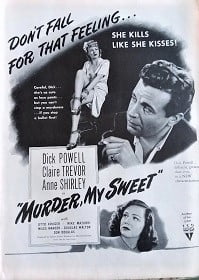 Dick Powell’s breakout film (briefly mentioned above) was 1944’s noir classic Murder, My Sweet. Based on Raymond Chandler’s detective character Philip Marlowe from his 1940 novel Farewell, My Lovely, the film was released with the book’s title but audience reaction was tepid at best, the feeling being that the title wasn’t dark enough and audiences assumed it was just another of Powell’s many light romances he had been making since the 1930s (30+ such roles from 1932-1939), in which he played handsome young men who wooed women with his boyish good looks, musical ability, and crooning voice. Getting older, and desirous of more mature roles that fit his middle aged demeanor, he convinced the powers that be to give him the role of Marlowe from Chandler’s novel. It was quite a gamble but Powell pulled it off admirably and the film is now recognized as a noir classic. When the film was released in late December of 1944 with the novel’s title and proved unsuccessful at the box office, it was quickly retitled Murder, My Sweet and re-released in February of 1945 in St. Louis with much better results. The box office and critical acclaim following the film led to several other noir films of note with Powell in the lead: Johnny O’Clock (1947, in which he played a detective), To the Ends of the Earth (1948, crime noir), and Pitfall (also 1948, film noir where he starred as a bored insurance agent who falls in love with the wrong woman).
Dick Powell’s breakout film (briefly mentioned above) was 1944’s noir classic Murder, My Sweet. Based on Raymond Chandler’s detective character Philip Marlowe from his 1940 novel Farewell, My Lovely, the film was released with the book’s title but audience reaction was tepid at best, the feeling being that the title wasn’t dark enough and audiences assumed it was just another of Powell’s many light romances he had been making since the 1930s (30+ such roles from 1932-1939), in which he played handsome young men who wooed women with his boyish good looks, musical ability, and crooning voice. Getting older, and desirous of more mature roles that fit his middle aged demeanor, he convinced the powers that be to give him the role of Marlowe from Chandler’s novel. It was quite a gamble but Powell pulled it off admirably and the film is now recognized as a noir classic. When the film was released in late December of 1944 with the novel’s title and proved unsuccessful at the box office, it was quickly retitled Murder, My Sweet and re-released in February of 1945 in St. Louis with much better results. The box office and critical acclaim following the film led to several other noir films of note with Powell in the lead: Johnny O’Clock (1947, in which he played a detective), To the Ends of the Earth (1948, crime noir), and Pitfall (also 1948, film noir where he starred as a bored insurance agent who falls in love with the wrong woman).
Powell was also active in television as actor, director, and producer. Arguably his best known TV endeavor was Dick Powell’s Zane Grey Theater or as it came to be known, simply Zane Grey Theatre (1956-1961). It was a western anthology series based on the works of Zane Grey, but as time went on new material was added to keep the stories fresh. It guest-starred many of the most well known or beloved and/or major TV/movie stars of the day, including but not limited to: Anne Bancroft, Robert Blake, Ernest Borgnine, Lloyd Bridges, Claudette Colbert, Hedy Lamarr, Julie London, Ginger Rogers, James Garner, Dennis Hopper, Burl Ives, Michael Landon, Edward G. Robinson, Jack Lemmon, David Niven, John Dehner, Burt Reynolds, Lon Chaney, Jr., Barbara Stanwyck, and many more. Much beloved in Hollywood and throughout the country by his legion of fans, Dick Powell died on February 3, 1963. His widow, well known actress June Allyson, gave his cause of death as lung cancer due to his chain smoking. Powell has a star on the Hollywood Walk of Fame.
[Left: Murder, My Sweet poster – Right: Virginia Gregg & Dick Powell]
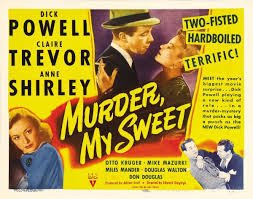
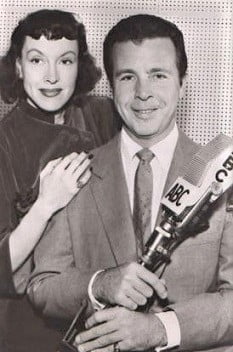
“The Betty Moran Case” was one of the earliest Richard Diamond episodes and showcased all of the elements that would make it such a popular show. The production values were quite high, which of course was a major plus for a demanding, sophisticated radio audience by this time in radio history. The quality of the writing was top-notch as were the performances by the main characters: Powell, Gregg, and Begley, and the mystery itself was a worthy one. This episode starts out strong, with a murder and two dead bodies, and a disconsolate widower asking for Diamond’s help. Notice that I didn’t say two murders, but one murder and two dead bodies, for Diamond’s remit here is finding evidence—if there is any—to refute the police report of the second dead body (the widower’s wealthy wife) being a suicide. If it turns out to be a double murder, then who was the murderer, and what was his or her motive? If it turns out to be a murder/suicide then why did the presumed murderer of the first corpse turn around and immediately commit suicide? There are two possible scenarios, each with more questions than answers, and it is up to Diamond to unravel the complicated knot of clues he would soon file as “The Betty Moran Case.”
I would like to thank Bob Byrne for suggesting this episode. Bob is a diehard, highly knowledgeable aficionado of the hard-boiled and noir detective sub-genres, whether they be in print, radio, tv, or film, and writes regularly about them in several online venues. Maybe he’ll get around to writing about “The Betty Moran Case,” aka “Double Murder” sometime in the future. (For those interested in learning more about the hard-boiled and/or noir sub-genres of detective fiction, Bob hosts a popular Facebook page devoted to them here.)
Play Time: 29:32
{The neighborhood gang, like many youngsters of their day, enjoyed playing cowboys and Indians and cops and robbers. After listening to this episode of Richard Diamond it was no surprise that on their next visit to the corner newsstand they would seek out a few of their favorite detective magazines (having previously bought all of their regular SF magazines, of course). Crack Detective Stories (1938-57) would survive no fewer than eight name changes during its long run. From November 1943 through September 1949 it sported the title on the issue shown below. It was a bi-monthly in 1949. Dime Detective (1931-53) was another long-running favorite, and its longevity, at least in part, came from the talent it was able to gather within its pages—names like Carroll John Daly featured on the cover of the issue below. Daly is best known for writing the first of what would come to be known as the “hard-boiled” story (“The False Burton Combs,” Black Mask, November 1922), and for his Race Williams character which debuted in the June 1, 1923 issue of Black Mask with the anti-Klu Klux Klan story “Knights of the Open Palm.” It would see publication a little over four months before Dashiell Hammett’s own Private Investigator stories featuring the Continental Op appeared in the October 1923 issue of Black Mask. Dime Detective was a monthly in 1949. New Detective (1941-53) promised a new direction in detective stories, but though it favored the police procedural it was still able to attract some of the most popular detective/crime writers in the field. It was a bi-monthly in 1949.]
[Left: Crack Detective Stories, May 1949 – Center: Dime Detective, May 1949 – Right: New Detective, May 1949]
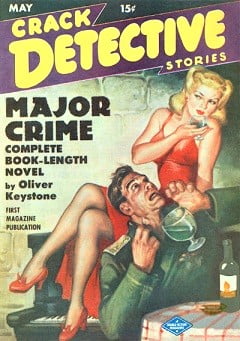
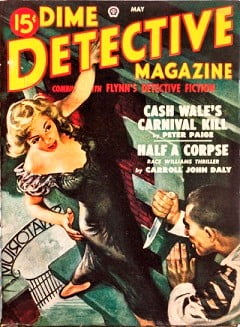

To view the entire list of weekly Old Time Radio episodes at Tangent Online, click here.